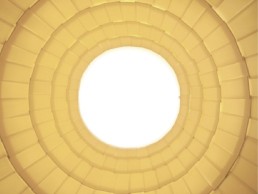
The Perfect Glow
Natural light triggers a primeval response in us all. Who can deny the attraction of firelight and candles? In terms of atmosphere – no artificial light source can compete with the organic – even in these days of LED colour controllers. The simple warming glow of certain shades is unrivalled. That is why I and so many lighting and interior designers love porcelain. Surely it is the premier medium for the creation of an ambient relaxing and welcoming interior?
Apart for instances where task and function is required – many schemes avoid the use of direct light. The practice of using reflected light from a hidden source and washing light across walls are central to contemporary lighting design and there are many ways to achieve this effect. Filtering the light source through a shade is an alternative that allows for the creation of sculptured focal points in an interior. Porcelain succeeds here too. The material is wonderfully flexible and can flow into any dramatic form to fit the look of a space.
Of course diffused light can be generated by many materials but none offer the warmth and honey like glow of translucent porcelain. To create the ideal light, porcelain has to be cast paper thin and fired at very high temperatures to achieve a shade that emits pure ambience. It is ideal in bars and restaurants as it conveys conviviality. Many designers use it as a practical and fire safe alternative to candles. It flatters complexions too! Moreover it signals a warm welcome. It is used very effectively in office receptions and hotel foyers (after all the word foyer is derived from the French for fire). I know of no other lighting medium that can ‘warm’ a space more effectively.
Porcelain also makes a surprisingly happy marriage with LED light sources. You may expect a collision between this ancient material and the latest technology but you will be delighted with the result. Of course tungsten lamps are warmer in their original state but a combination of a 3000K LED through the warming filter of porcelain provides a crisp illumination which is joyous. Combine this with a RGB colour controller and you discover hues of light which have a wonderful natural intensity. A dawn-blue through a tree canopy and twilight pinks are just a few delights. Effectively porcelain expands the natural palette of light that can be achieved with artificial light sources.
Porcelain as a material is renowned for its ability to capture fine detail and relief. It adds another factor that is so loved by enthusiasts of this medium. I encountered the subtle use of light and darks in an original McCloud design – the Gracie. The raw and rough texture gave the fitting a unique appeal. I also appreciate embossed wallpaper designs and natural textures when embedded. A porcelain shade when lit can reveal textures that draw the eye and can echo patterns from the fabrics and furnishings elsewhere in the interior scheme.
In this increasingly technological world of lighting it is important to remember the importance of the natural and the organic. I challenge anyone not to be struck by the unique aesthetic that a porcelain chandelier, pendant or wall light offers. Sometimes things are better experienced than described. I invite all designers to take a look at porcelain next time they want to create a warm atmospheric space. It is a light that suits the contemporary, traditional and the classic interior in equal measure.
Andrew Orange – Lighting Designer and Consultant
www.houseoforange.co.uk



